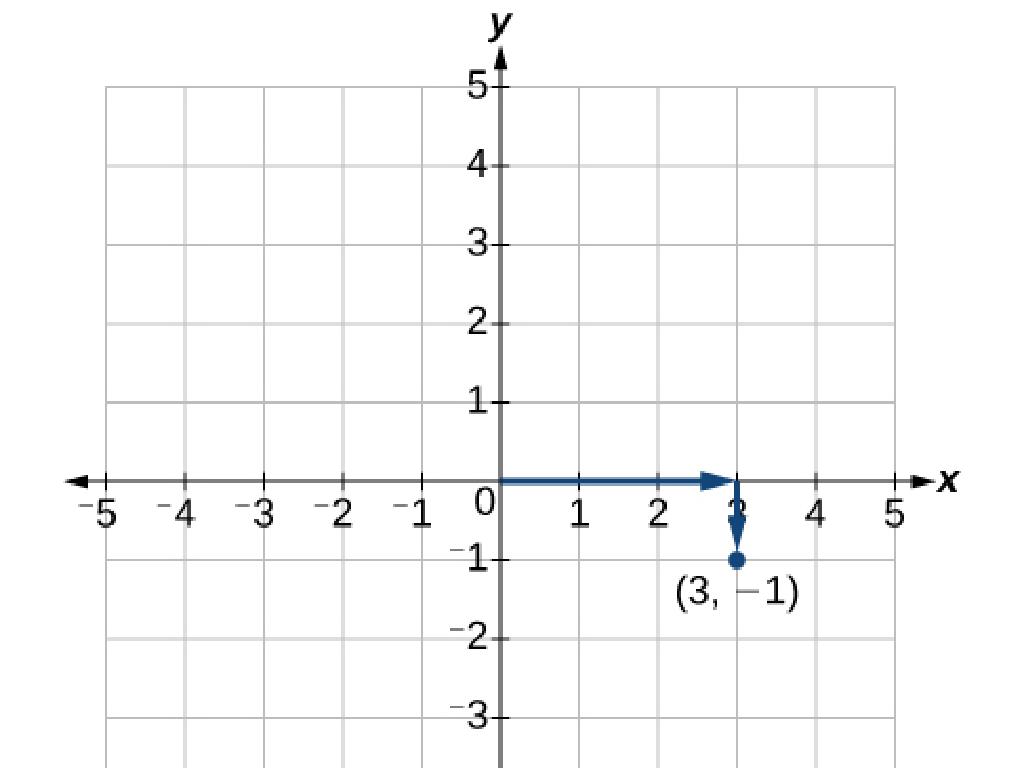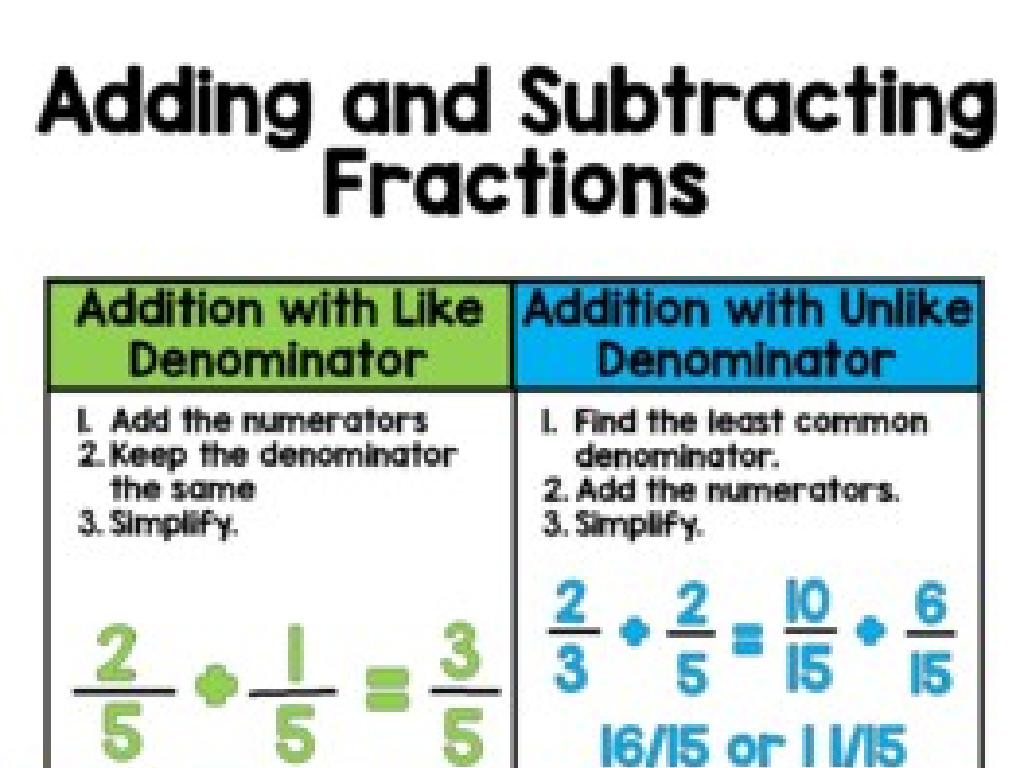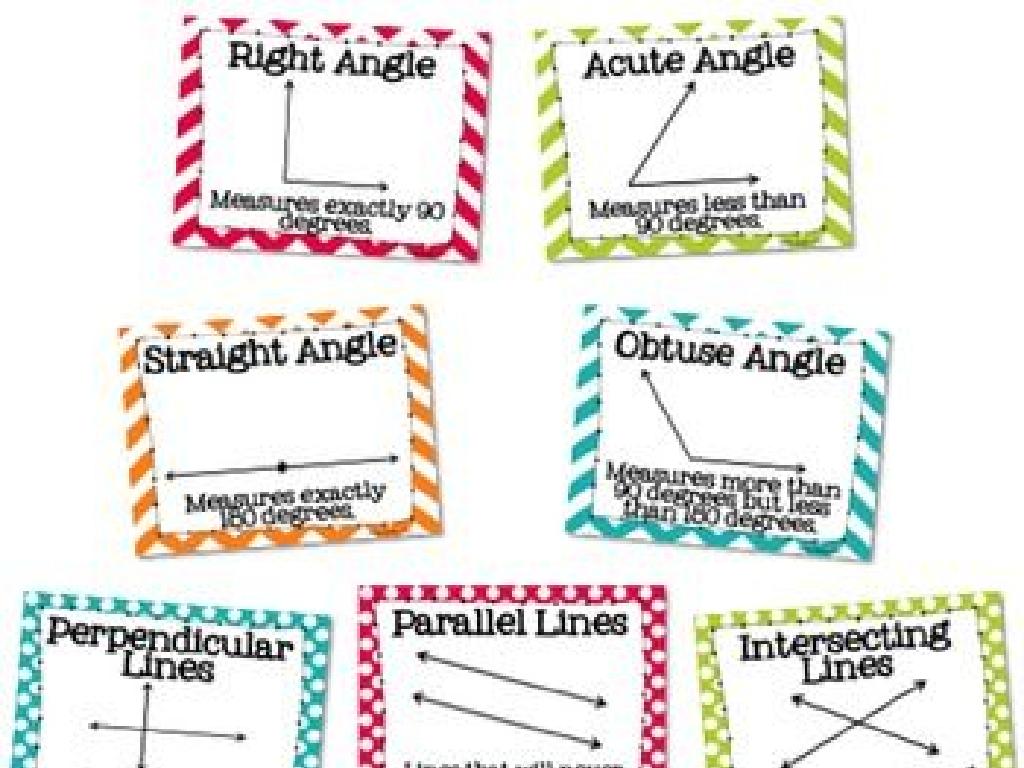Interpret Charts And Graphs To Find Mean, Median, Mode, And Range
Subject: Math
Grade: Eighth grade
Topic: One-Variable Statistics
Please LOG IN to download the presentation. Access is available to registered users only.
View More Content
Understanding One-Variable Statistics
– Grasp basic statistical concepts
– Statistics involve collecting, analyzing, interpreting, and presenting data.
– Learn Mean, Median, Mode, and Range
– Mean is the average, Median is the middle value, Mode is the most frequent, Range is the difference between highest and lowest.
– Real-life applications of statistics
– Use these measures to summarize data from sports, economics, weather, etc.
– Enhancing decision-making skills
– Knowing these concepts helps us make informed choices based on data trends.
|
This slide introduces students to the fundamental concepts of one-variable statistics, emphasizing the importance of mean, median, mode, and range. It’s crucial to explain that statistics is more than just numbers; it’s a way to understand the world. Illustrate how these measures are used in everyday life, such as in calculating average grades, determining the most popular items, or budgeting. Encourage students to think of examples where they encounter averages or ranges, like in sports statistics or weather forecasts. This will help them see the practical value of statistics in making decisions, predictions, and understanding complex information.
Understanding Mean in Statistics
– Mean: The average of numbers
– Mean is calculated by adding all the numbers in a set and dividing by the number of items.
– Calculate mean: Sum numbers, divide by count
– Add up all the values, then divide by how many values there are.
– Example: Mean of data points
– If the data points are 3, 5, 7, the mean is (3+5+7)/3 = 5.
– Significance of mean in data analysis
– Mean provides a single value representing the center of the data.
|
The slide introduces the concept of mean, which is a fundamental statistical measure used to find the average value in a data set. It’s important to explain that the mean is calculated by summing all the numbers and dividing by the total count of numbers. Provide an example with a simple set of numbers to illustrate the calculation. Emphasize the significance of mean as it gives us an idea of the central tendency of the data, which is useful in comparing different data sets or understanding the overall performance of a group. Encourage students to practice with different sets of numbers to become comfortable with the concept.
Understanding Median in Statistics
– Median: The middle value
– Median is the middle number in an ordered set
– Finding median in odd-numbered sets
– If the set has an odd count, the median is the center number
– Finding median in even-numbered sets
– For even count, average the two middle numbers
– Example: Calculating the median
– Arrange data points in order, then locate the median
|
The median is a measure of central tendency that indicates the middle value of a dataset when ordered from least to greatest. For an odd number of data points, the median is simply the middle number. For an even number of data points, the median is found by averaging the two middle numbers. For example, in the dataset [3, 5, 7, 9, 11], the median is 7, as it is the middle value. However, in the dataset [3, 5, 7, 9], the median is the average of 5 and 7, which is 6. Encourage students to practice with different datasets to become comfortable with finding the median. This concept is crucial for understanding data distribution and is widely used in statistics.
Understanding Mode in Statistics
– Define mode in datasets
– Mode: The number that appears most often in a set of data
– Recognize bimodal datasets
– A dataset may have one mode, more than one (bimodal), or no mode
– Example: Finding the mode
– Given data: 3, 7, 3, 2, 9, 10, 3 – Mode is 3, as it appears most frequently
– Mode’s role in data analysis
|
The mode is a basic statistical measure that represents the most common value in a dataset. It’s important for students to understand that while a set of data may have a single mode, it can also have multiple modes (bimodal) or no mode at all if no number repeats. Use the example provided to show how to identify the mode by counting the frequency of each number. Emphasize that mode is particularly useful in understanding the distribution of categorical data, such as survey responses. Encourage students to practice with different datasets to become comfortable with finding the mode.
Understanding Range in Statistics
– Range: Difference between extremes
– Range is the spread of values in a data set.
– Calculating range: High minus low
– Subtract the smallest value from the largest value in the set.
– Example: Data set range calculation
– For the set 3, 7, 5, 13, 20, range is 20 – 3 = 17.
|
The concept of range is a fundamental statistical measure that indicates the variability within a set of data. It’s calculated by identifying the highest and lowest numbers in the set and then subtracting the smallest from the largest. This slide will introduce students to the definition of range and how to calculate it with a simple subtraction. Provide an example with a small data set to illustrate the process. Encourage students to practice by finding the range of different sets of numbers to solidify their understanding. This will prepare them for more complex statistical concepts.
Interpreting Graphs: The 4 M’s of Statistics
– Reading various graph types
– Calculate Mean, Median, Mode, Range
– Mean: Average value, Median: Middle value, Mode: Most frequent, Range: Difference between highest and lowest
– Practice with a given graph
– Use the graph to find the 4 M’s: Mean, Median, Mode, and Range
– Understanding real-world applications
– How these measures help us in daily life, like understanding trends in weather or economics
|
This slide introduces students to the basics of interpreting graphs and finding key statistical measures. Start by explaining how to read different types of graphs such as bar graphs, line graphs, and histograms. Then, guide students through the process of calculating the mean, median, mode, and range from graphical data. Provide a practice graph and ask students to find these measures. Emphasize the importance of these concepts by discussing their real-world applications, such as analyzing data trends or making informed decisions based on statistical information. For the activity, consider using diverse graphs to ensure students can apply the concepts to different scenarios. Provide step-by-step solutions for each measure and encourage students to discuss their methods and results.
Class Activity: Let’s Analyze Data!
– Group activity with diverse graphs
– Each group calculates statistical measures
– Find the average (mean), middle value (median), most frequent (mode), and difference between highest & lowest (range)
– Document mean, median, mode, and range
– Present findings to the class
|
Divide the class into small groups and provide each with a unique graph or dataset. The task for each group is to calculate the mean, median, mode, and range of the data presented in their graph. They should document their process and results. After calculations, each group will present their findings to the class, explaining how they determined each measure and what these statistics tell us about the data. For the teacher: Prepare diverse graphs beforehand, ensure they have varying levels of complexity, and provide clear instructions. Consider having a worksheet for students to fill in their calculations. Possible activities could include graphs from real-life data, such as sports statistics, classroom test scores, or weather patterns.
Conclusion: Understanding Measures of Central Tendency
– Recap: Mean, Median, Mode, Range
– Mean (average), median (middle), mode (most frequent), range (difference between highest and lowest)
– Significance in statistics
– These measures summarize data sets for analysis
– Homework: Practice worksheet
– Complete worksheet to interpret statistical data
– Apply knowledge to charts/graphs
– Use these measures to analyze real-world data
|
As we conclude today’s lesson, remember that mean, median, mode, and range are essential tools for summarizing and understanding data. They each provide different insights into the distribution of a data set. For homework, students will complete a worksheet that requires them to practice interpreting charts and graphs using these measures. This will help solidify their understanding and prepare them for analyzing real-world statistical data. Encourage students to think about how these measures can be applied in various fields such as economics, science, and sports analytics.





